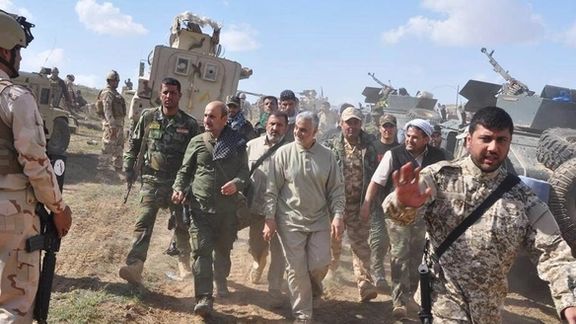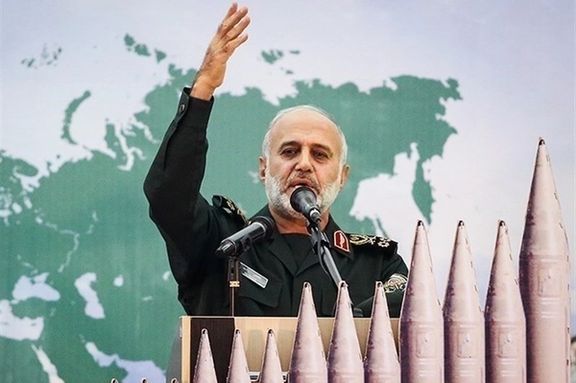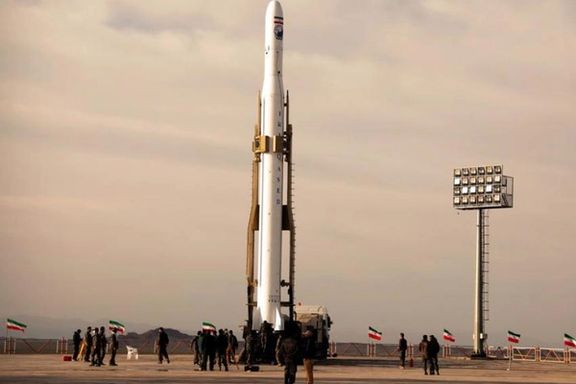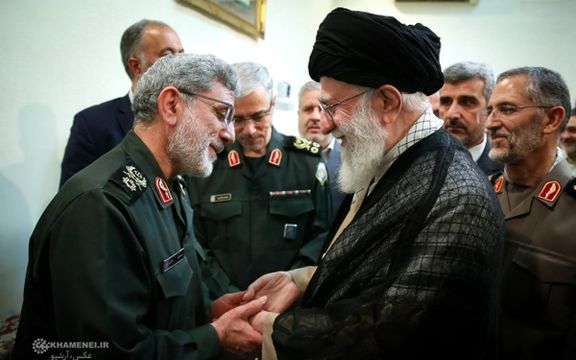Iran Fires Cruise Missiles During Persian Gulf Drills

Iran’s Revolutionary Guard (IRGC) has fired cruise missiles and other weapons during its ongoing military drills in the Persian Gulf and the Strait of Hormuz.

Iran’s Revolutionary Guard (IRGC) has fired cruise missiles and other weapons during its ongoing military drills in the Persian Gulf and the Strait of Hormuz.
On the second day of the military maneuvers on Tuesday, five anti-ship cruise missiles were fired from the shore and Zolfaghar fast patrol naval vessels at designated targets on the sea, the IRGC said.
IRGC also put to test the latest version of its single-engine tactical unmanned aerial vehicle, named Mohajer, capable of carrying a multispectral surveillance payload and up to two precision-guided munitions.
The operations also included Bavar missile air defense system and Sukhoi Su-22, old Russian fighter-bombers, as well as surface-to-surface ballistic missiles.
The five-day drills involve various IRGC units, such as the aerospace force and the cyber-electronic division and covers the coastlines of the southern provinces of Hormozgan, Bushehr, and Khuzestan.
About a fifth of oil consumed globally passes through the strategic Hormuz Strait in the Persian Gulf, where periodic confrontations have taken place between Iran’s military and the US Navy.

A top Israeli intelligence official has confirmed his country’s role in the assassination of Iranian Quds Force commander Qasem Soleimani last year.
The former head of Military Intelligence, Major-General Tamir Hayman, disclosed the information in an interview with an Israeli magazine.
Soleimani was killed in a targeted US drone strike as he arrived at Baghdad airport on January 3, 2020.
A few days after he was killed, NBC News reported that Israeli intelligence helped the US through its informants at the Damascus airport who tipped off the CIA about the time Soleimani's plane took off for Baghdad.
Another report published in Mayhad said that Israel gave the US access to Soleimani’s multiple cellphone numbers to help track him, but no top official had acknowledged Israel’s role before.
“The assassination of Soleimani was an achievement since our main enemy, in my eyes, is Iran,” Hayman said. “It is rare to locate someone so senior who is also the operator on the ground, the strategist and the fighter.”
He added that Israel has carried out multiple operations to disrupt the spread of Iranian weapons and funds throughout the region but described Soleimani’s killing as one of “two significant and important assassinations” during his tenure, the other being Islamic Jihad leader Baha Abu al-Ata.
“We thwarted a lot of ways they tried to smuggle weapons and money and the headline of all of this is stopping the Iranians from entrenching themselves in Syria,” he said.

Iran’s Revolutionary Guard launched large-scale air and naval drills in the Persian Gulf on Monday, while pledging a tough repsonse to Israel in case of attack.
Earlier, some media outlets reported that anti-aircraft fire was heard around Iran’s sole nuclear power plant at Bushehr, on the Persian Gulf.
State media later reported that the sounds were related to an air defense exercise as part of the larger drills, while warning Tehran would give a "crushing response" to any Israeli attack.
"This air defense exercise took place at 5 a.m. local time (0130 GMT) with full preparation and coordination with the armed forces," Bushehr's deputy governor Mohammadtaghi Irani told Iranian state media.
Iran has accused Israel of several attacks on facilities linked to its nuclear program and killing its nuclear scientists over the past years. Israel has neither denied nor confirmed the allegations.
Israel has long threatened military action against Iran, and recently reportedly allocated $1.5 billion for an attack if Iran gets dangerously close to obtaining a nuclear weapon.
The escalation comes as world powers have been discussing the revival of the 2015 Iranian nuclear deal limiting Iran’s nuclear program, which Israel has opposed.
Iran has warned of a "crushing" response to any Israeli move against the Islamic Republic.
"If Israel carries out attacks against Iran, our armed forces will immediately attack all centers, bases, routes, and spaces used to carry out the aggression," Iranian commander Gholamali Rashid said, according to Nournews.
The spokesman of the joint drills, codenamed The Great Prophet 17, said on Monday that the five-day military maneuvers will be conducted by IRGC’s ground forces, air force, and navy in cooperation with the cyber electronic wing of the IRGC along the coastal regions of three southern provinces of Hormozgan, Bushehr, and Khuzestan.
General Abbas Nilforoushan added that the maneuver is simulated based on a hybrid warfare model to display the country's military might.
About a fifth of oil that is consumed globally passes through the strategic Strait of Hormuz Strait in the Persian Gulf, where periodic confrontations have taken place between Iran’s military and the US Navy.
Indirect talks between Iran and the United States to reinstate the nuclear pact have made little discernible progress since they resumed last month for the first time since Iran's hardline president, Ebrahim Raisi, was elected in June.
The 2015 deal lifted sanctions against Tehran in return for restrictions on Iran's nuclear activities aimed at extending the time Tehran would need to obtain enough fissile material for a nuclear bomb if it chose to - so-called breakout time - to at least a year from roughly two to three months.
In response to Trump's "maximum pressure" policy, Iran in 2019 started breaching the deal's nuclear restrictions and pressing ahead further with its atomic activities. Iran has enriched more than 200 kilograms of uranium to 20 and 60 percent purity, substantially reducing the time needed to produce a bomb.
Tehran says its nuclear steps are reversible if all sanctions are lifted in a verifiable process.
With reporting by Reuters, Iran media

Iran’s communication minister said Saturday "there will be good news” about launching a satellite until March, after recent reports about preparations at a launch site.
The Associated Press reported earlier this week that evidence points to Iran preparing a space launch and Iranian media offered a list of upcoming planned satellite launched.
In his first press conference, communication minister Issa Zarepour said that Iran’s space program was put on the backburner during former president Hassan Rouhani’s eight-year administration (2013-2021), but now its budget has increased. He added that the country needs a ten-year plan to expand its satellite program to put vehicles at a higher orbit.
Currently, Iran can reach 500 kilometers into space, which is considered a lower orbit. President Hassan Rouhani ordered officials to aim for the 36,000-kilometer orbit and increased the space program budget up to 12 times.
Foreign observers and governments have charged that Iran's space program is a cover to justify its testing of ballistic missiles. Israel and the United States have said that Iran's space program is against a UN resolution banning Iranian missiles with nuclear weapons capability.

A bipartisan legislation was introduced Thursday at the US Senate Foreign Relations Committee to prevent Iran and its proxy groups from acquiring lethal drones.
The Committee’s ranking member Jim Risch (R-Idaho) and Chairman Bob Menedez (D-NJ) introduced the Senate version of the Stop Iranian Drones Act of 2021, which passed the House of Representatives Foreign Affairs Committee on December 10.
A statement by the Foreign Relations Committee said the legislation “seeks to amend the Countering America’s Adversaries Through Sanctions Act (CAATSA) to include any action that seeks to advance Iran’s UAV program...as sanctionable under U.S. law.”
In an interview with the Associated Press on December 10, commander of CENTCOM Gen. Kenneth McKenzie also expressed concern over the growing capabilities of Iranian missiles and drones.
Iran’s military drone program has expanded in recent years and UAV’s have been more frequently used in attacks in recent months both on land and at sea. Several attacks in Iraq and at least one attack in Syria have targeted US forces.
Senator Risch said, “As we saw with recent Iranian-sponsored drone attacks on American troops and the Iraqi Prime Minister, as well as the constant attacks on Saudi Arabia, Iran’s armed drone capability presents a growing threat to the Middle East.

The US State Department says Iran continues to harbor al Qaeda leaders and sponsor terrorism acts, in its 2020 Country Reports on Terrorism published Thursday.
“There has been facilitation of them that allows them to remain active as leaders within the al-Qaida global enterprise,” the acting Coordinator for Counterterrorism John T. Godfrey said Thursday at a briefing introducing the 2020 report. “No secret, I think, that Iran is a longstanding state sponsor of terrorism, and I think the fact that they have enabled that leadership cadre to safely reside in Iran is a reflection of their use of terrorism as an adjunct of their foreign policy goals.”
Godfrey also said that Iran continued to support terror acts in the region “and further afield in 2020”, supporting proxies in Iraq, Lebanon, Syria, Yemen and Bahrain, including Hezbollah and Hamas.
The United States also continued high-level diplomatic contacts to counter Hezbollah’s presence in Central and South America and in Europe, resulting in nine countries taking “significant steps” in 2020 “to designate, ban, or otherwise restrict” Hezbollah.
In response to a question as to how the Biden Administration is cooperating with Saudi Arabia to counter Iranian proxy forces Godfrey said, “I think Saudi Arabia has faced a particular threat in recent years from the Houthis in Yemen, and obviously that’s a group that has enjoyed quite a bit of support from Iran, and we’ve been public about our concerns about that. And that’s something that we’ve continued to work with them on.”
However, the Biden Administration removed the Houthis from a terror designation list almost as soon as it took office in early February and since then has repeatedly condemned their missile and drone attacks against Saudi Arabia.
In the report itself, the State Department says, “The Houthis continue to receive material support and guidance from Iranian entities, including to enable attacks against Saudi Arabia. These attacks have utilized armed drones and ballistic missiles, which damaged airports and critical infrastructure.”
The report highlights the role of IRGC’s Qods (Quds) Force saying that Iran continued to acknowledge the active role the military-intelligence unit plays in regional conflicts from Iran and Syria to Yemen and elsewhere. It also says that Hezbollah “remained Iran’s most dangerous terrorist partner and the most capable terrorist organization in Lebanon, controlling areas across the country. Iran’s annual financial backing to Hizballah — which in recent years has been estimated to be in the hundreds of millions of dollars — accounts for most of the group’s annual budget.”